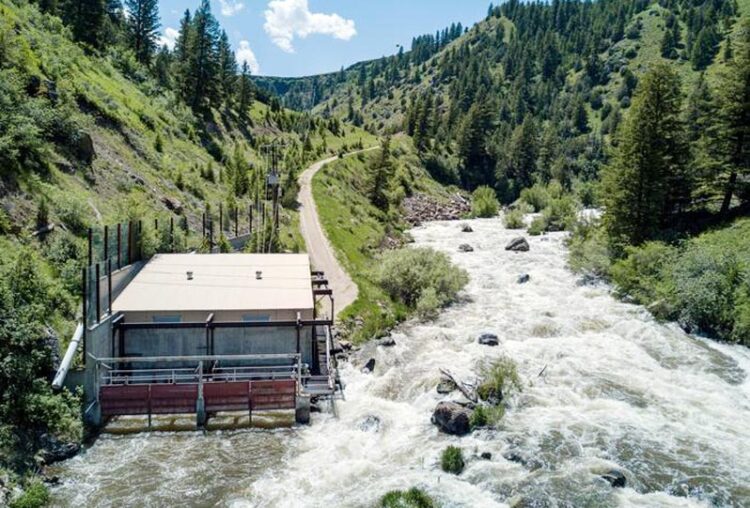New tech brings resilience to small-town hydropower

Fall River Electric Cooperative Hydropower Plant on the Teton River near Felt, Idaho.
Credit: Idaho National Laboratory
Idaho National Laboratory (INL) celebrated the ribbon-cutting of its new Microgrid in a Box, which was deployed in partnership with the Fall River Electric Cooperative at its hydropower plant in rural Idaho. Using newly developed technologies, INL researchers demonstrated that hydropower, coupled with a mobile microgrid, can enable small communities to maintain critical services during emergencies. During today’s ribbon-cutting, power from the Microgrid in a Box was combined with power generated from the hydropower plant to restore electrical supply after a simulated electrical grid blackout in a process called a “blackstart.”
The new technologies showcased, developed by INL and sponsored by the U.S. Department of Energy’s Water Power Technologies Office, demonstrate how communities with similar resources can maintain critical services during blackout emergencies.
“There are hundreds of hydropower plants like this one serving small communities across the country,” said Thomas Mosier, INL’s Energy Systems Group lead. “What we’ve demonstrated are new technologies that can enable these communities to use the hydropower resources they already have to restart and maintain stable power to essential services, even during an emergency event.”
Nearly 70 people attended the event, representing utilities, government agencies and industry from across the country.
WHAT IS THE MICROGRID IN A BOX?
The Relocatable Resiliency Alternative Power Improvement Distribution Microgrid in a Box, also known as RAPID MIB, is a portable, self-contained grid system developed by INL engineers in collaboration with private industry and government customers. It enables integration and optimization of multiple energy sources — such as hydropower, solar panels, wind turbines, diesel generators or even small nuclear reactors — to ensure a reliable and resilient power supply in remote or off-grid locations, or during emergency situations or power outages.
“Restarting a grid isn’t as simple as flipping a switch,” said Kurt Myers, INL’s Energy and Grid Systems Integration group lead. “It requires a steady power input that many small utilities alone can’t provide. Combining the tech built in to the Microgrid in a Box with the existing capabilities of the Fall River plant, we’re showing how communities with limited resources can recover and continue to function during an emergency.”
WHAT IS A BLACKSTART?
Blackstart refers to the process of restarting and energizing power generation units, transmission lines and distribution systems to restore electricity supply after a blackout or widespread power disruption.
INL continues to innovate approaches for efficiently recovering the power grid during these critical situations. This includes studying the resiliency and reliability of power systems, designing advanced control and communication systems, and testing new approaches to optimize the blackstart process.
SUPPORTING RURAL UTILITIES
Many rural communities have untapped energy resources that can enable them to maintain services, even during emergency events. INL, with support from the Water Power Technologies Office, is proud to partner with utilities like the Fall River Electric Cooperative to demonstrate and test these new technologies.
“Fall River Electric Cooperative is focused on investing in technology that can improve the lives of our owner-members and this partnership with INL is a prime example,” said Fall River CEO Bryan Case. “The Microgrid in a Box test has accelerated our ability to deploy a hydropower and battery system to provide our members with electricity in the event of natural disasters or other local emergencies.”
Through research, analysis, simulations and real-world testing like the blackstart demonstrated at the ribbon-cutting event, INL is enhancing the ability of power utilities to recover from blackouts and minimize the impact on communities and critical infrastructure.
About Idaho National Laboratory
Battelle Energy Alliance manages INL for the U.S. Department of Energy’s Office of Nuclear Energy. INL is the nation’s center for nuclear energy research and development, and also performs research in each of DOE’s strategic goal areas: energy, national security, science and the environment. For more information, visit www.inl.gov. Follow us on social media: Twitter, Facebook, Instagram and LinkedIn.
About Fall River Electric
Fall River is a customer-owned, nonprofit electric utility with over 15,000 owner-members providing electrical service to portions of three states including Idaho, Montana and Wyoming. Fall River is committed to safely and economically providing reliable energy and other services that bring value to its members. For more information visit www.fallriverelectric.com.
Media Contact
Sarah Neumann
DOE/Idaho National Laboratory
sarah.neumann@inl.gov
Office: 208-526-0490
All latest news from the category: Power and Electrical Engineering
This topic covers issues related to energy generation, conversion, transportation and consumption and how the industry is addressing the challenge of energy efficiency in general.
innovations-report provides in-depth and informative reports and articles on subjects ranging from wind energy, fuel cell technology, solar energy, geothermal energy, petroleum, gas, nuclear engineering, alternative energy and energy efficiency to fusion, hydrogen and superconductor technologies.
Newest articles

A universal framework for spatial biology
SpatialData is a freely accessible tool to unify and integrate data from different omics technologies accounting for spatial information, which can provide holistic insights into health and disease. Biological processes…

How complex biological processes arise
A $20 million grant from the U.S. National Science Foundation (NSF) will support the establishment and operation of the National Synthesis Center for Emergence in the Molecular and Cellular Sciences (NCEMS) at…

Airborne single-photon lidar system achieves high-resolution 3D imaging
Compact, low-power system opens doors for photon-efficient drone and satellite-based environmental monitoring and mapping. Researchers have developed a compact and lightweight single-photon airborne lidar system that can acquire high-resolution 3D…





















